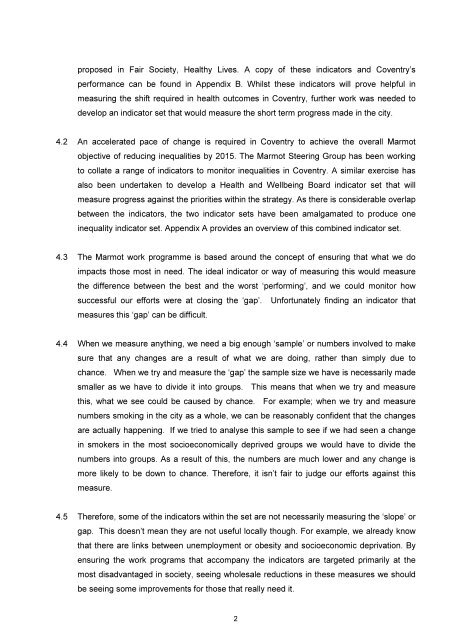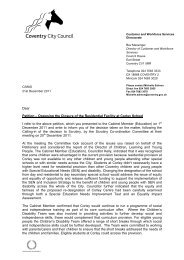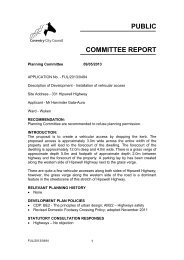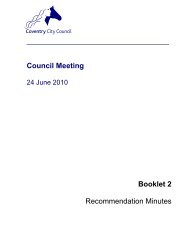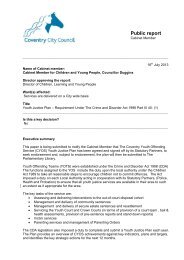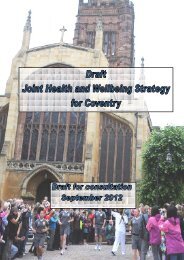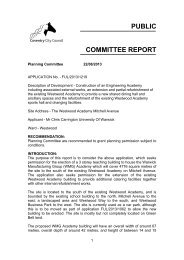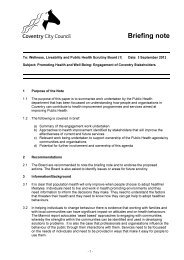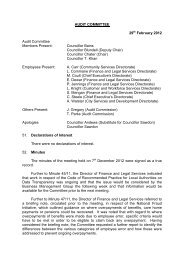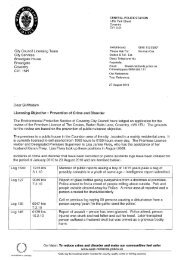Briefing note - Meetings, agendas, and minutes - Coventry City ...
Briefing note - Meetings, agendas, and minutes - Coventry City ...
Briefing note - Meetings, agendas, and minutes - Coventry City ...
Create successful ePaper yourself
Turn your PDF publications into a flip-book with our unique Google optimized e-Paper software.
proposed in Fair Society, Healthy Lives. A copy of these indicators <strong>and</strong> <strong>Coventry</strong>’s<br />
performance can be found in Appendix B. Whilst these indicators will prove helpful in<br />
measuring the shift required in health outcomes in <strong>Coventry</strong>, further work was needed to<br />
develop an indicator set that would measure the short term progress made in the city.<br />
4.2 An accelerated pace of change is required in <strong>Coventry</strong> to achieve the overall Marmot<br />
objective of reducing inequalities by 2015. The Marmot Steering Group has been working<br />
to collate a range of indicators to monitor inequalities in <strong>Coventry</strong>. A similar exercise has<br />
also been undertaken to develop a Health <strong>and</strong> Wellbeing Board indicator set that will<br />
measure progress against the priorities within the strategy. As there is considerable overlap<br />
between the indicators, the two indicator sets have been amalgamated to produce one<br />
inequality indicator set. Appendix A provides an overview of this combined indicator set.<br />
4.3 The Marmot work programme is based around the concept of ensuring that what we do<br />
impacts those most in need. The ideal indicator or way of measuring this would measure<br />
the difference between the best <strong>and</strong> the worst ‘performing’, <strong>and</strong> we could monitor how<br />
successful our efforts were at closing the ‘gap’. Unfortunately finding an indicator that<br />
measures this ‘gap’ can be difficult.<br />
4.4 When we measure anything, we need a big enough ‘sample’ or numbers involved to make<br />
sure that any changes are a result of what we are doing, rather than simply due to<br />
chance. When we try <strong>and</strong> measure the ‘gap’ the sample size we have is necessarily made<br />
smaller as we have to divide it into groups. This means that when we try <strong>and</strong> measure<br />
this, what we see could be caused by chance. For example; when we try <strong>and</strong> measure<br />
numbers smoking in the city as a whole, we can be reasonably confident that the changes<br />
are actually happening. If we tried to analyse this sample to see if we had seen a change<br />
in smokers in the most socioeconomically deprived groups we would have to divide the<br />
numbers into groups. As a result of this, the numbers are much lower <strong>and</strong> any change is<br />
more likely to be down to chance. Therefore, it isn’t fair to judge our efforts against this<br />
measure.<br />
4.5 Therefore, some of the indicators within the set are not necessarily measuring the ‘slope’ or<br />
gap. This doesn’t mean they are not useful locally though. For example, we already know<br />
that there are links between unemployment or obesity <strong>and</strong> socioeconomic deprivation. By<br />
ensuring the work programs that accompany the indicators are targeted primarily at the<br />
most disadvantaged in society, seeing wholesale reductions in these measures we should<br />
be seeing some improvements for those that really need it.<br />
2


